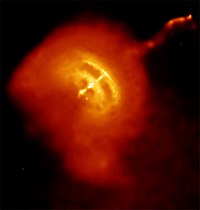Vela pulsar
| Observation data Epoch J2000 Equinox J2000 |
|
|---|---|
| Constellation | Vela |
| Right ascension | 08h 35m 20.65525s |
| Declination | −45° 10′ 35.1545″ |
| Apparent magnitude (V) | 23.6 |
| Astrometry | |
| Distance |
959+248 −163 ly (294+76 −50pc) |
| Other designations | |
The Vela Pulsar (PSR J0835-4510 or PSR B0833-45) is a radio, optical, X-ray- and gamma-emitting pulsar associated with the Vela Supernova Remnant in the constellation of Vela.
It spins 11.195 times per second (i.e. a period of 89.33 milliseconds—the shortest known at the time of its discovery) and the remnant from the supernova explosion is estimated to be travelling outwards at 1,200 km/s (750 mi/s). It has the third-brightest optical component of all known pulsars (V = 23.6 mag) which pulses twice for every single radio pulse. The Vela pulsar is the brightest persistent object in the high-energy gamma-ray sky.
The association of the Vela pulsar with the Vela Supernova Remnant, made by astronomers at the University of Sydney in 1968, was direct observational proof that supernovae form neutron stars.
Studies conducted by Kellogg et al. with the Uhuru spacecraft in 1970–71 showed the Vela pulsar and Vela X to be separate but spatially related objects. The term Vela X was used to describe the entirety of the supernova remnant. Weiler and Panagia established in 1980 that Vela X was actually a pulsar wind nebula, contained within the fainter supernova remnant and driven by energy released by the pulsar.
On 12 May 2015, a NASA research balloon was launched from Alice Springs in Australia's Northern Territory, taking aloft instruments developed as a joint project between Nagoya University and Kobe University in Japan to measure gamma ray output from the Vela Pulsar. The flight was expected to end near Longreach, Queensland, after sunset.
...
Wikipedia

